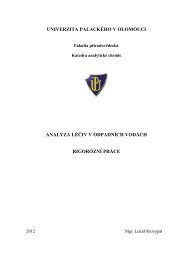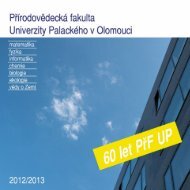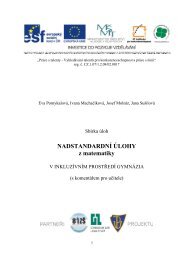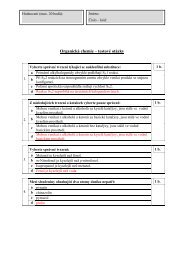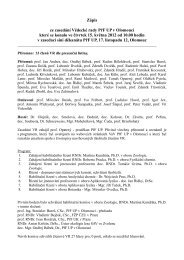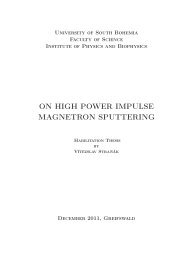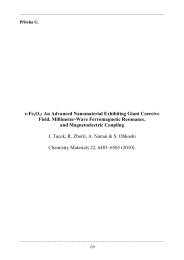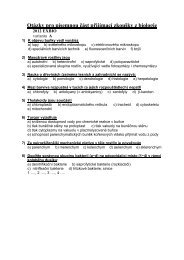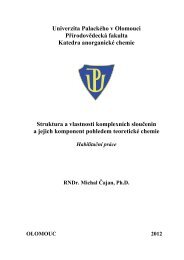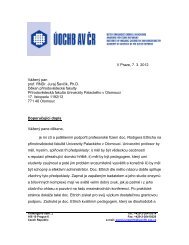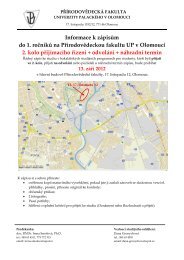A comparative structural analysis of direct and indirect shoot ...
A comparative structural analysis of direct and indirect shoot ...
A comparative structural analysis of direct and indirect shoot ...
Create successful ePaper yourself
Turn your PDF publications into a flip-book with our unique Google optimized e-Paper software.
E Balus"ka et al.: Mitogen-activated protein kinase SIMK in alfalfa 263<br />
signaling <strong>of</strong> a multitude <strong>of</strong> extracellular stimuli <strong>and</strong><br />
bring about a large variety <strong>of</strong> specific responses.<br />
We have investigated whether hyperosmotic stress<br />
in plants is also mediated by MAP kinase pathways.<br />
We have found that SIMK (stress-inducible MAP<br />
kinase) (originally named MsK7; Jonak et al. 1993) is<br />
activated by hyperosmotic stress in alfalfa cells<br />
(Munnik et al. 1999). In suspension-cultured cells,<br />
SIMK was found to be a constitutively nuclear protein<br />
<strong>and</strong> was not undergoing changes in its intracellular<br />
location upon salt stress. In this report, we have investigated<br />
the presence <strong>and</strong> localization <strong>of</strong> SIMK in<br />
alfalfa roots. Our results indicate that the tissuespecific<br />
pattern <strong>and</strong> subcellular localization <strong>of</strong> SIMK<br />
is influenced by both cell cycle cues <strong>and</strong> environmental<br />
conditions.<br />
Material <strong>and</strong> methods<br />
Plant material <strong>and</strong> sample preparation<br />
Seeds <strong>of</strong> Medicago sati a L. cv. Europa were placed on moist filter<br />
paper in petri dishes <strong>and</strong> germinated for 3 days in cultivating chambers<br />
in darkness at 25 ~ For salt stress treatment roots <strong>of</strong> 3-dayold<br />
seedlings were incubated in 0 or 200 mM NaC1. 8 mm long root<br />
tips were fixed in 3.7% formaldehyde in stabilizing buffer [SB;<br />
50 mM piperazine-N, N9-bis(2-ethanesulfonic acid), 5 mM MgSO4,<br />
5 mM EGTA, pH 6.9] for 1 h. After rinsing in SB <strong>and</strong> phosphatebuffered<br />
saline (PBS), root tips were dehydrated in a graded ethanol<br />
series diluted with PBS. The root tips were then infiltrated with<br />
Steedman's wax diluted in absolute ethanol in step with the proportion<br />
1 : 1 (ethanol <strong>and</strong> wax, v/v), followed by 2 steps in pure<br />
wax. The infiltrated root tips were allowed to polymerize in pure<br />
wax at room temperature overnight. All chemicals, if not stated<br />
otherwise, were obtained from Sigma Chemical Co. (St. Louis, Mo.,<br />
U.S.A.).<br />
Antibody production <strong>and</strong> specificity<br />
M23 antibody was produced against a synthetic peptide, encoding<br />
t]~e carboxyl-terminal amino acids FNPEYQQ <strong>of</strong> SIMK (Jonak<br />
et al. 1993). The antibody was found to monospecifically detect<br />
SIMK, <strong>and</strong> preincubation <strong>of</strong> the antibody with an excess <strong>of</strong> the<br />
synthetic petide completely blocked immun<strong>of</strong>luorescent labeling <strong>of</strong><br />
SIMK in suspension-cultured cells (Munnik et al. 1999) <strong>and</strong> root<br />
sections (data not shown).<br />
In<strong>direct</strong> immun<strong>of</strong>luorescence microscopy<br />
7 mm thick median longitudinal sections were prepared from the<br />
fixed root tips <strong>and</strong> mounted on slides coated with glycerol-albumen<br />
(Serva, Heidelberg, Federal Republic <strong>of</strong> Germany). Sections<br />
exp<strong>and</strong>ed in a drop <strong>of</strong> distilled water, <strong>and</strong> they were allowed to<br />
adhere to the slides. For easy penetration <strong>of</strong> antibodies, the sections<br />
were first dewaxed in ethanol, rehydrated in an ethanol <strong>and</strong> PBS<br />
series, <strong>and</strong> kept in PBS for 30 min After a 10 rain methanol treatment<br />
at -20 ~ <strong>and</strong> a SB rinse for 30 min at room temperature, the<br />
sections were incubated with affinity-purified SIMK-specific antibody<br />
diluted 1 : 1000 with PBS for 60 rain at room temperature.<br />
After a rinse in SB the sections were incubated with secondary fluorescein<br />
isothiocyanate-conjugated anti-rabbit immunoglobulin G<br />
raised in goat (Sigma) diluted 1 : 100 with PBS for 60 min at room<br />
temperature in darkness. Nuclear DNA was stained with 49,6-<br />
diamidino-2-pheuylindole (DAPI) diluted at 1 g/ml PBS for 10 rain.<br />
After rinsing with PBS, the sections were stained with 0.01%<br />
Toluidine Blue in PBS for 10 rain <strong>and</strong> mounted in antifade mountant<br />
medium containing p-phenylenediamine. Immun<strong>of</strong>luorescence<br />
observation was examined with an Axiovert 405M inverted light<br />
microscope (Zeiss, Oberkochen, Federal Republic <strong>of</strong> Germany) <strong>and</strong><br />
Olympus BX 50 (Olympus, Tokyo, Japan) microscope equipped with<br />
epifluorescence <strong>and</strong> st<strong>and</strong>ard FITC exciter <strong>and</strong> barrier filters (BP<br />
450-490 nm wavelength, LP 520 nm wavelength). Photographs were<br />
taken on Kodak T-Max films rated at 400 ASA.<br />
Results<br />
Cell cycle phase-dependent localization <strong>of</strong> SIMK<br />
SIMK encodes a MAPK that was recently identified<br />
to be activated by salt stress in suspension-cultured<br />
cells, leaves, <strong>and</strong> roots (Munnik et al. 1999). In suspension-cultured<br />
cells, salt stress was not found to<br />
alter the subcellular localization <strong>of</strong> SIMK. However,<br />
suspension-cultured cells are constantly exposed to<br />
mechanical stress (shaking), conditions that were<br />
found to activate SIMK, albeit to a much smaller<br />
extent than salt stress (Munnik et al. 1999). To study<br />
the behavior <strong>and</strong> localization <strong>of</strong> SIMK in a more<br />
natural system, roots <strong>of</strong> 3-day-old alfalfa seedlings<br />
were analyzed before <strong>and</strong> after salt stress. Figure 1<br />
shows immun<strong>of</strong>luorescence pictures taken from longitudinal<br />
sections <strong>of</strong> nonstressed root tips. To correlate<br />
SIMK localization with the cell cycle stages, the sections<br />
were also stained with DAPI <strong>and</strong> compared. By<br />
this <strong>analysis</strong>, proliferating cells <strong>of</strong> the meristematic<br />
region revealed a predominantly nuclear localization<br />
<strong>of</strong> SIMK in interphase cells. In accordance with<br />
the cell cycle phase-dependent expression found in<br />
suspension-cultured cells (Jonak et al. 1993), G2 phase<br />
cells (Fig. 1 A) had higher amounts <strong>of</strong> SIMK protein<br />
than cells in other stages. Interestingly, in mitosis <strong>and</strong><br />
early-Gl-phase cells, S1MK was found to accumulate<br />
in the newly formed nuclei as well as with the assembling<br />
cell plates <strong>and</strong> young cell walls (Fig. 1 A). These<br />
results prompted us to perform a more thorough<br />
<strong>analysis</strong> <strong>of</strong> the localization <strong>of</strong> SIMK during different<br />
mitotic stages. In prophase, metaphase, <strong>and</strong> anaphase,<br />
SIMK was clearly excluded from the condensing chromosomes<br />
<strong>and</strong> the spindle apparatus (Fig. 1 C-J). In<br />
telophase (lower cell in Fig. 1 K, L), SIMK started to<br />
accumulate at the periphery <strong>of</strong> the reforming nuclei<br />
(Fig. 1 K). At a slightly later stage <strong>of</strong> mitosis (upper cell




